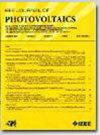Exploring Optical and Electronic Properties of 2D Lead-Free Hybrid Perovskites Based on Sn-Ge for Photovoltaic Applications
IF 2.5
3区 工程技术
Q3 ENERGY & FUELS
引用次数: 0
Abstract
2D perovskites have recently become a promising substitute for 3D structures. In 2D lead-free perovskites, unique optical and electronic properties for photoelectronic and photovoltaic applications have been observed due to the quantum confinement effect. In this study, density functional theory calculations were used to examine both the electrical and optical characteristics of lead-free, 2D compounds of (PEA) 2 MI 4 (PEA = C 6 H 5 C 2 H 4 NH 3 + , M = Ge, Sn, Sn 0.5 Ge 0.5 ). The results of our research have shown that (PEA) 2 GeI 4 , (PEA) 2 SnI 4 , and (PEA) 2 Sn 0.5 Ge 0.5 I 4 have a direct bandgap of about 1.0 eV, 1.2 eV, and 1.4 eV, respectively. By adding Sn to structure (PEA) 2 GeI 4 , it was possible to notice a redshift of the absorption edge and band gap shrinking in the visible light range, which demonstrates the special optical characteristics of structure (PEA) 2 Sn 0.5 Ge 0.5 I 4 for photovoltaic applications. It is revealed that (PEA) 2 Sn 0.5 Ge 0.5 I 4 compound has a suitable bandgap and high optical absorption and conductivity in the visible region. In addition, low reflectivity, high absorption, high conductivity, and high dielectric constant imply that these materials have a high potential for use in photovoltaic and optoelectronic devices, including optical detectors, LED, solar cells, etc.用于光伏应用的基于Sn-Ge的二维无铅混合钙钛矿的光学和电子特性探索
2D钙钛矿最近已经成为3D结构的一种很有前途的替代品。在二维无铅钙钛矿中,由于量子限制效应,已经观察到用于光电和光伏应用的独特光学和电子特性。在本研究中,使用密度泛函理论计算来检验(PEA)2MI4(PEA=C6H5C2H4NH3+,M=Ge,Sn,Sn0.5Ge0.5)的无铅2D化合物的电学和光学特性。通过在结构(PEA)2GeI4中添加Sn,可以注意到吸收边的红移和在可见光范围内的带隙收缩,这证明了结构(PEA)2Sn0.5Ge0.5I4在光伏应用中的特殊光学特性。结果表明,(PEA)2Sn0.5Ge0.5I4化合物具有合适的带隙,在可见光区域具有较高的光吸收和电导率。此外,低反射率、高吸收、高导电性和高介电常数意味着这些材料在光伏和光电子器件中具有很高的应用潜力,包括光学探测器、LED、太阳能电池等。
本文章由计算机程序翻译,如有差异,请以英文原文为准。
求助全文
约1分钟内获得全文
求助全文
来源期刊

IEEE Journal of Photovoltaics
ENERGY & FUELS-MATERIALS SCIENCE, MULTIDISCIPLINARY
CiteScore
7.00
自引率
10.00%
发文量
206
期刊介绍:
The IEEE Journal of Photovoltaics is a peer-reviewed, archival publication reporting original and significant research results that advance the field of photovoltaics (PV). The PV field is diverse in its science base ranging from semiconductor and PV device physics to optics and the materials sciences. The journal publishes articles that connect this science base to PV science and technology. The intent is to publish original research results that are of primary interest to the photovoltaic specialist. The scope of the IEEE J. Photovoltaics incorporates: fundamentals and new concepts of PV conversion, including those based on nanostructured materials, low-dimensional physics, multiple charge generation, up/down converters, thermophotovoltaics, hot-carrier effects, plasmonics, metamorphic materials, luminescent concentrators, and rectennas; Si-based PV, including new cell designs, crystalline and non-crystalline Si, passivation, characterization and Si crystal growth; polycrystalline, amorphous and crystalline thin-film solar cell materials, including PV structures and solar cells based on II-VI, chalcopyrite, Si and other thin film absorbers; III-V PV materials, heterostructures, multijunction devices and concentrator PV; optics for light trapping, reflection control and concentration; organic PV including polymer, hybrid and dye sensitized solar cells; space PV including cell materials and PV devices, defects and reliability, environmental effects and protective materials; PV modeling and characterization methods; and other aspects of PV, including modules, power conditioning, inverters, balance-of-systems components, monitoring, analyses and simulations, and supporting PV module standards and measurements. Tutorial and review papers on these subjects are also published and occasionally special issues are published to treat particular areas in more depth and breadth.
 求助内容:
求助内容: 应助结果提醒方式:
应助结果提醒方式:


